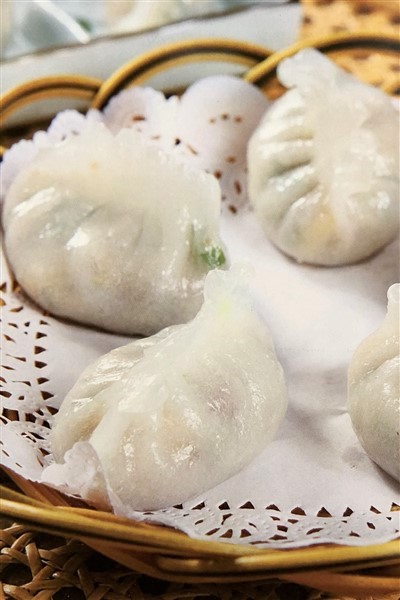Fun Guo
Steamed Dumplings Stuffed Full of Flavor
Fun guo is a traditional pastry from Guangzhou. Its dough skin and shape is similar to shrimp dumplings, but it is slightly bigger and not necessarily crescent-shaped. Its filling includes shrimp, pork, barbecue pork, shiitake mushrooms, and more, which makes it taste different than shrimp dumplings. Another difference between fun guo and shrimp dumplings is that fun guo can be either steamed or pan-fried with oil.

Ingredients
- 2 ½ cups (300 grams) potato starch
- scant 1/2 cup (50 grams) wheat starch
- 3.52 ounces (100 grams) shrimp
- 7.05 ounces (200 grams) picnic ham
- 1.76 ounces (50 grams) Cantonese barbecue pork
- 1.76 ounces (50 grams) dried, shelled shrimp
- 1.76 ounces (50 grams) shiitake mushrooms
- 3.52 ounces (100 grams) peanuts
- 0.88 ounce (25 grams) garlic chives
Seasonings
- 2 teaspoons (8 grams) salt
- 1 heaping teaspoon (5 grams) sugar
- 1 heaping teaspoon (5 grams) chicken bouillon
- 1 scant teaspoon (3 milliliters) sesame oil
- 1 teaspoon (5 milliliters) light soy sauce
- appropriate amount of cooking oil
- appropriate amount of water-starch solution
Cooking Directions
Preparations
- Soak shiitake mushrooms in warm water, then remove stems. Dice. Wash picnic ham and mince. Remove shells and de-vein shrimp. Wash and dice, then strain away water. Wash dried, shelled shrimp, then strain away water and dice. Wash garlic chives, then dice. Dice barbecue pork. Heat peanuts in frying pan, then remove peanut shells. Mix in blender.
How to make the filling
- Heat pan, then add a bit of cooking oil. First, add diced ham, shrimp, and dried, shelled shrimp. Fry until aromatic, then add barbecue pork, shiitake mushrooms, blended peanuts, salt, sugar, chicken bouillon, sesame oil, and light soy sauce. Stir fry together, then add a bit of water-starch solution to thicken. Remove from pot. Add garlic chives and mix together. This is the filling.
How to make the dough
- Combine scant 1/2 cup (50 grams) potato starch with wheat starch. Add 0.4 cup water. Mix evenly. Add 0.4 cup boiling water and mix to add heat to the solution. Add another 1 ¼ cups boiling water and let soak for 1 minute, allowing the solution to heat thoroughly.
- Pour out boiling water. Add 2 cups (250 grams) potato starch to dough. Use a pressing and folding technique to mix potato starch and dough. Cover in plastic wrap to ensure dough remains moist.
How to make fun guo skins
- Sprinkle a bit of potato starch on cutting board. Divide dough into long strips of equal size, then cut into pieces approximately 0.7 ounce (20 grams) each. Form these pieces into balls, then use rolling pin to press them into circular dough skin wrappers which are thick in the middle and thin along the edges.
Put it all together
- Add appropriate amount of filling to center of wrapper. Fold tightly into a cockscomb shape. This is the uncooked fun guo.
- Lay oil paper or moist gauze at the bottom of a steamer basket. Place fun guo inside, leaving ample space between each one.
- Add appropriate amount of water to steamer pot. After bringing to a boil over high heat, place steamer basket inside. Steam for approximately 3 minutes. Serve.
- Tip: You may brush a bit of cooking oil over the fun guo after steaming to enhance its luster.
The Origin of Fun Guo
Teochew fun guo is also known as "E'jie's fun guo" because, as legend has it, they were invented by a maid named E'jie.
During the 1920's or 30's, a government official in the Xiguan area of Guangzhou had E'jie make several dim sum dishes for a dinner party. After much consideration, E'jie made a dough with boiling water and flour. She then made a filling with fried pork, shrimp, and shiitake mushrooms, and then wrapped them up in the dough and steamed them. The finished dim sum dish was shaped like the core of an olive. It had white, translucent skin, and it was smooth and moist. E'jie called them "fun guo". Everybody who ate it said it tasted amazing.
When the owner of the nearby Fragrant Teahouse heard about this new dim sum dish, he spent a lot of money to hire E'jie. He also built a glass partition in his restaurant so that patrons could not only enjoy the taste of fun guo, but they could watch E'jie make them as well. The addition of E'jie and her fun guo was great for business, and fun guo continued to grow in popularity.